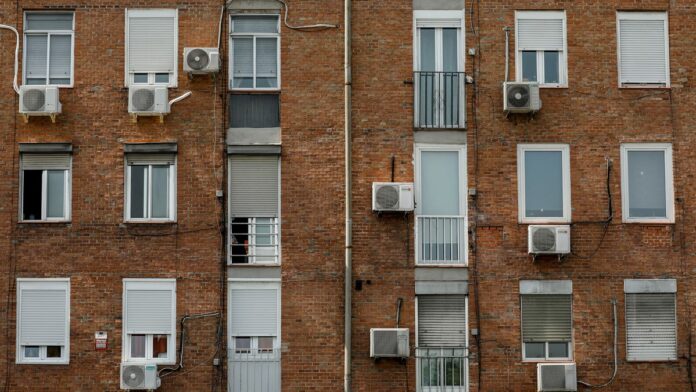Could better ventilation have prevented covid from becoming a pandemic that killed millions of people?
Even if there’s no definitive answer, there are reasons to think that cleaner indoor air could have offered a defense against the SARS-CoV-2 virus. And certainly the pandemic brought the debate around indoor air quality to a head—to the point that, last week, the US Centers for Disease Control and Prevention (CDC) set a firm target for ventilation: five air changes per hour.
The same day, the Association of Heating, Refrigeration, and Air-Conditioning Engineers (ASHRAE) published a draft (pdf) of the group’s first-ever industry standard for mitigating infectious aerosols. The standard proposes minimum ventilation, filtration, and air cleaning requirements for different settings like offices, schools, gyms, and healthcare settings.
The science around how best to ventilate to control infection is not quite clear yet, said Yuguo Li, a professor of mechanical engineering at the University of Hong Kong, who has long studied the role of airflow and ventilation in the transmission of viruses. But ASHRAE’s draft standard is “a very good starting point,” he said.
In 2005, Li co-authored a widely cited paper investigating the airborne transmission of SARS-CoV, the coronavirus that caused the 2003 SARS outbreak. (The novel coronavirus, the cause of the covid-19 pandemic, is genetically related to the SARS virus.) Li and his colleagues arrived at their results by tracing the initial 200 or so SARS infections to several building blocks in a large Hong Kong residential complex. Similar work has since studied the vertical transmission of covid in Hong Kong apartment buildings.
As early as April 2020—18 months before World Health Organisation used the term “airborne” in relation to covid— Li and colleagues in China published a pre-print showing the probable aerosol transmission of covid in a poorly ventilated restaurant, where the ventilation rate was around one liter per second person.
The metrics of ventilation—flow rates, air changes, filtration—may be complicated. But in the simplest of terms, said Joey Fox, a heating, ventilation and air conditioning systems (HVAC) engineer based in Canada, “the solution to everything is making the indoors more like the outdoors.” Fresh air disperses viruses and other particulate matter, making them less harmful to humans. Three years into the pandemic, we know that most covid transmission happens indoors, particularly in poorly ventilated spaces. Improving indoor air will reduce the spread of covid, with major implications for public health everywhere.
How clean should indoor air be?
One common measure of the rate at which a room is ventilated is how much air flows in and out, in liters per second. Another is air changes per hour, or the number of times the total volume of air in a space is completely removed and replaced with new air.
The CDC’s new ventilation target for reducing the concentration of viral particles is five air changes per hour. That is significantly higher than the recommended 0.35 ACH for homes in an existing ASHRAE standard.
“I believe, for the ancestral strain of the virus in the first half year [of 2020], if all spaces were ventilated at eight to 10 liters per second per person, as commonly required, and people wear masks—or even if they don’t wear masks—I would say that the pandemic would have been intercepted,” Li said.
Li takes the 10 litres per second measurement from passenger airplanes, which are typically ventilated to that level. “From the reported plane outbreaks, we know that R0 < 1,” Li told Quartz. Here, R0 referred to the virus’s reproductive number, which determines how many other people will catch covid from a single infected person. The critical threshold is one, below which an outbreak gradually fades out. On well-ventilated planes with constant air flow, in other words, the virus tended to stay contained.
Li offered one caveat: that even higher levels of ventilation may not have been able to stop the spread of the much more transmissible omicron variant. But if the original coronavirus strain had been slowed or even stopped with good ventilation in the first place, it would have had less opportunity to mutate into more infectious and virulent variants.
Covid isn’t the only reason to improve our indoor air
Of course, quality indoor air isn’t just a question of covid. Other airborne contaminants like fine particulate matter—generated through cooking or chemicals—and poisonous gases like nitrogen dioxide and formaldehyde can also negatively impact health and comfort. The US government currently has no established standard for regulating indoor levels of such particulate matter.
But done right, covid could serve as the same kind of catalyst for better indoor air as cholera did for better sewage and cleaner water in the 19th century. “We might be on the verge of an indoor air quality revolution, and it could be among the most important public health victories of the 21st century,” Joseph Allen, an associate professor at Harvard’s school of public health and director of the university’s Healthy Buildings program, wrote in a recent essay.
The targets and set by the CDC and ASHRAE are merely a first step, though. They have to be incorporated into new builds and enforced by regulators. The standards are “very ambitious,” Fox said. “How [they are] actually going to be implemented and play out, we don’t know yet… In some places, it does seem like it could be a very difficult thing to do.”
Part II: How to tackle the global indoor air crisis


